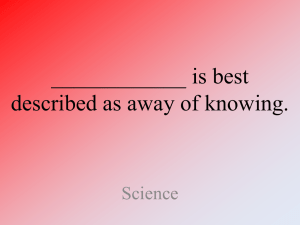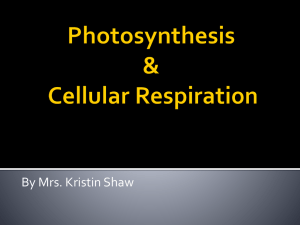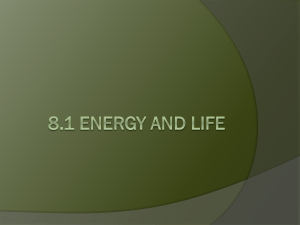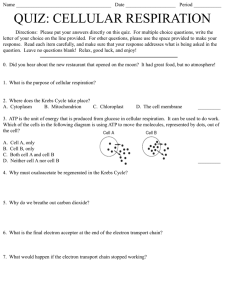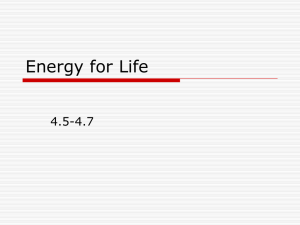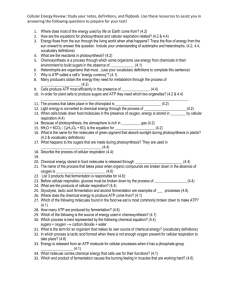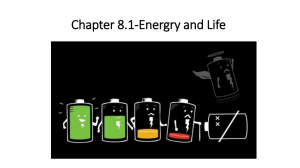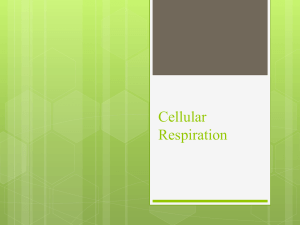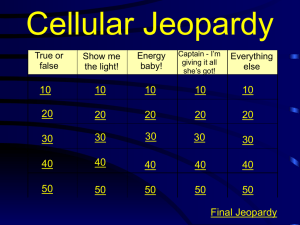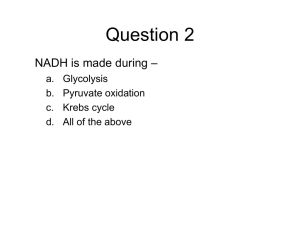cell energy notes
advertisement
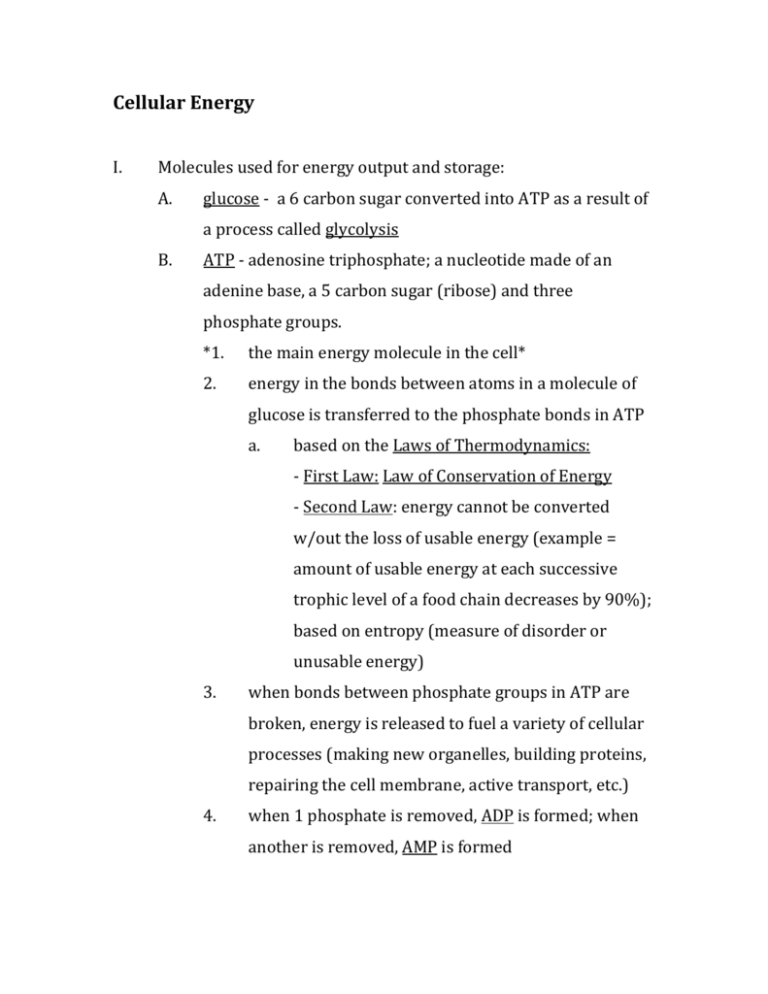
Cellular Energy I. Molecules used for energy output and storage: A. glucose - a 6 carbon sugar converted into ATP as a result of a process called glycolysis B. ATP - adenosine triphosphate; a nucleotide made of an adenine base, a 5 carbon sugar (ribose) and three phosphate groups. *1. the main energy molecule in the cell* 2. energy in the bonds between atoms in a molecule of glucose is transferred to the phosphate bonds in ATP a. based on the Laws of Thermodynamics: - First Law: Law of Conservation of Energy - Second Law: energy cannot be converted w/out the loss of usable energy (example = amount of usable energy at each successive trophic level of a food chain decreases by 90%); based on entropy (measure of disorder or unusable energy) 3. when bonds between phosphate groups in ATP are broken, energy is released to fuel a variety of cellular processes (making new organelles, building proteins, repairing the cell membrane, active transport, etc.) 4. when 1 phosphate is removed, ADP is formed; when another is removed, AMP is formed 5. when free phosphate groups re-join AMP to make ADP or re-joins ADP to make ATP, energy is again stored in the bonds for later use C. chemical reactions fueled by ATP make up the cell's metabolism D. a series of chemical reactions in the cell requiring energy from ATP is called a metabolic pathway - 2 types: 1. catabolic - breaks down large molecules (glucose) into small molecules to release energy (cellular respiration) 2. anabolic - builds large molecules from smaller ones using energy (from sunlight) (photosynthesis) II. Cellular Respiration A. Catabolic - occurs in both autotrophs and heterotrophs but only in cells containing mitochondria. B. process by which mitochondria break down food molecules to produce ATP: 3 stages. C. Aerobic Respiration: 1. Glycolysis - "sugar dissolving" or "glucose" "break down" a. process in which both plant and animal cells use 2 ATP molecules to break down glucose into 2 pyruvate molecules, resulting in 4 total ATP molecules or a net production of 2ATPs. b. takes place in the cytoplasm but sends the resulting ATPs to the mitochondria. c. uses the electron carrier NAD+ to form NADH when it accepts 2 electrons 2. Citric Acid cycle or Kreb's cycle a. each pyruvate from glycolysis is used to make 1 more ATP, citric acid, and CO2; b. takes place in the matrix of the mitochondria c. uses the electron carriers NAD+ and FAD to make NADH and FADH2 d. 3. produces 2 ATPs Electron Transport Chain a. the final step in the breakdown of glucose. b. takes place in the inner membrane of the mitochondria c. electron carriers (NADH and FADH2) deliver electrons to the top of the chain d. electrons are passed from protein (carrier) to protein, releasing energy at each step (2nd Law of Thermodynamics) e. O2 is the final electron acceptor; no O2 and the process stops! f. Each NADH produces 3 ATPs and each group of 3 FADH2 produces 2 ATPs for a total of 32 ATPs 4. At the end of the cycle of the transformation of glucose to ATP, a total of 36 ATPs are produced. D. Anaerobic respiration 1. Fermentation: when no O2 is available, this is the back up plan! 2. Allows cellular respiration to continue; follows glycolysis 3. 2 types: a. alcoholic fermentation - occurs only in yeast and some bacteria - pyruvate is converted to ethyl alcohol and CO2; NADH becomes NAD+ so cycle can continue to electron transport chain - the reason fruit makes wine, bread rises, etc. b. lactic acid fermentation - occurs in muscle cells and in some bacteria - pyruvate is converted to lactic acid; NADH becomes NAD+ so cycle can continue to electron transport chain - this keeps the cell alive but is not very efficient: only 2ATPs result. - why muscles are sore after a work out 4. both types of fermentation or anaerobic processes take place in the cytoplasm then recycle to glycolysis so glycolysis can continue. 5. The purpose is to continue cellular respiration w/out O2. E. In summary: FOOD ---> GLUCOSE ---> ATP ---> ENERGY FOR CELL PROCESSES C₆H₁₂O₆ + 6O₂ → 6CO₂ + 6H₂O + energy is the formula for cellular respiration F. The mitochondria III. Photosynthesis A. Anabolic - occurs only in autotrophs in cells containing chloroplasts/chlorophyll. 1. chloroplasts - ("green" "form" - greek) - the site of photosynthesis in plant cells and cells of some other autotrophic organisms 2. chlorophyll is a green pigment that occurs in plants makes them green 3. appears green because green wavelengths of sunlight are not absorbed; energy for photosynthesis is obtained from other colors of the spectrum of sunlight that are absorbed, primarily red, orange, and green, blue (graph 1) 4. the more sunlight (light intensity) the chlorophyll is exposed to, the greater the rate of photosynthesis (graph 2) 5. the rate of photosynthesis can be measured by the amount of CO2 released or the amount of O2 remaining (not used up) (graph 3) B. process by which chloroplasts in autotrophs absorb light energy and convert it to chemical energy (ATP) and then use ATP to combine and rearrange CO2 and H2O to form glucose and H2O: 2 stages 1. Light Dependent reactions - convert light energy to chemical energy (ATP) a. takes place in the chloroplast in the thylakoid discs that are combined in stacks called grana (singular = granum); thylakoid contains the pigment chlorophyll. b. chlorophyll absorbs wavelengths of light energy from the sun c. the energy is transferred in the form of high energy electrons to electron carriers (NADP+) in the electron transport chain (bucket brigade); form NADPH d. high energy electrons flow down a concentration gradient, where protons accumulate in the thylakoid space - called chemiosmosis; produces ATP which forms in the stroma d. NADPH and ATP are stored in the chloroplast until used in the next phase 2. The Calvin Cycle (also called the light independent reactions) - convert s chemical energy (ATP) to chemical energy (glucose - a larger, more stable molecule for storage) a. first step is called carbon fixation because CO2 is joined with a 5 carbon compound b. After a series of steps in which glucose is formed, an enzyme called rubisco converts the remaining molecules to react with CO2 so the cycle can continue; rubisco converts inorganic molecules to organic molecules 3. Plants use the sugars formed in the Calvin cycle as a source of energy storage and to form complex carbohydrates such a cellulose, etc. C. IV. The chloroplast Chemical equations A. Cellular respiration C6H12O6 + 602 --> 6CO2 + 6H2O + energy Think: What takes in oxygen and gives off CO2? What process do animals do to accomplish this? What is another term for breathing? That tells you this is cellular respiration. What do they breathe out? That tells you that this is cellular respiration. B. Photosynthesis 6CO2 + 6H2O --> C6H12O6 + 602 Think: What do plants take in? What do they give off? What process do we associate with green plants? That tells you this is the equation for photosynthesis. C. The products of one equation are the reactants of the other!
